Ceramic washbasin as one of the most versatile sanitary
A porcelain or faience washbasin is almost a mandatory part of the interior of any bathroom or bathroom. Modern industry produces these products in a sufficiently large assortment, and in order to select the model that is suitable for your conditions, you need to study all the information below.
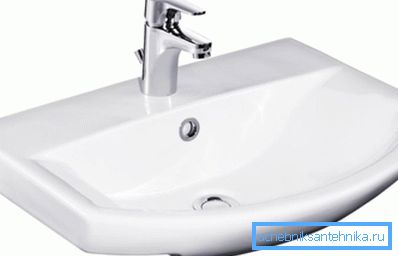
Product Description
general characteristics
Ceramic washbasins according to GOST are made from raw materials, including purified clay with mineral and synthetic additives. In production, the clay mass is first molded and then subjected to heat treatment in a kiln. As a result, we get a fairly dense and durable product, which is resistant to moisture and the effects of most chemicals.
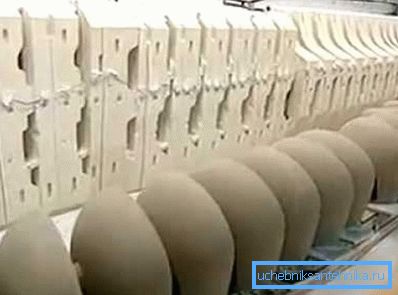
To give the sink aesthetic appearance of their polished, and then coated with icing. The glazed layer gives the surface a characteristic shine, in addition, it provides an easy cleaning of the washbasin from contamination.
As a rule, such constructions are produced in the form of a bowl designed for wall mounting. For operation, it is necessary to attach water supply and drain fittings, which are mounted in special grooves.
Main varieties
According to GOST 30493 96 such washbasins can be made in several forms and sizes.
The most commonly used configurations are:
- Semicircular.
- Trapezoidal.
- Oval.
- Rectangular.
- Corner.
Note! In a separate group, experts distinguish surgical and hairdressing shells, which can be completed with the back panel (back) and be produced without it.
As for the dimensions of the ceramic bowl, they are determined by the dimensional grid prescribed in GOST:
| Magnitude | Dimensions (ratio of width and length), mm | Depth (from upper edge to level of discharge) mm |
| one | 400x300 | 135 |
| 2 | 550x420 | 150 |
| 3 | 600x450 | 150 |
| four | 650x500 | 150 |
| five | 700x600 | 150 |
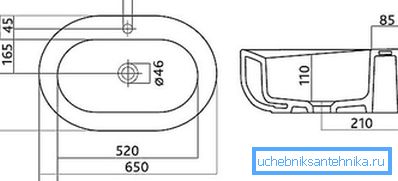
For corner models, the dimensional grid will be slightly different:
| Product type | Dimensions (ratio of width and length), mm | Depth (from upper edge to level of discharge) mm |
| Corner without back | 495x625 | 185 |
| Corner with back | 470x608 | 130 |
| Corner with overflow | 492x625 | 165 |
| Corner with cut corner | 390x540 | 165 |
| Surgical / Hairdressing | 590x650 | 190 |
Note! This dimensional grid is valid only for those products that are produced according to domestic standards. Products of foreign companies may have different dimensions, so before buying it is necessary to measure a specific instance.
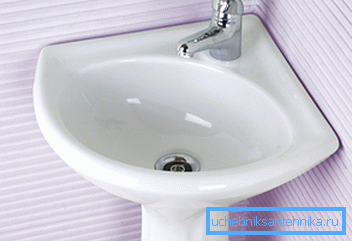
As for the material, there are such varieties:
- Porcelain sink. Porcelain has the highest density and durability, which leads to its good performance. Accordingly, the price of such a sink will be considerable, but it will last much longer than mass models.
- Semi porcelain washbasin. It is made from a mixture of components used to make porcelain and earthenware. Less durable than porcelain, but at the same time quite durable.
- Earthenware product - the most affordable, but at the same time, the least resistant. With long-term use, it loses its luster, and the coloring begins to fade. However, faience is quite suitable for domestic use.

Advantages and disadvantages
The main advantages

The popularity of porcelain and faience sinks due to an impressive list of their operational advantages.
Chief among them are:
- First, the materials used are chemically inert. Due to this, the washbasin does not oxidize even after prolonged contact with water, detergents do not damage it, and the surface remains smooth. The glaze layer that protects the surface of ceramics ensures long-term preservation of the original color, which is very important from the point of view of design.
- Secondly, ceramics is very environmentally friendly. Water in contact with the sink does not change its composition, which allows it to be used for washing without fear for your own health.
- Thirdly, thick-walled shells provide sufficient sound insulation. In any case, the sound of falling water, even under great pressure, they “jam” very high quality, and in the next room there is almost complete silence.
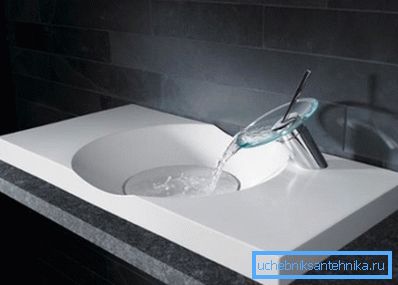
- Finally, it is worth mentioning the variety of products: for almost any bathroom and bathroom, you can choose a model that is suitable both in size and in appearance. And if we take into account that designer washstands have appeared on the market in recent decades, the choice becomes even more extensive.
The most current cons
The disadvantages of ceramic products include the following:
- First, the sink weighs a lot, so you need to mount it on a fairly strong hardware. If the walls in your bathroom are sheathed with plasterboard or plastic, then to install the faience bowl of the sink without a mortgage bar, fixed on the supporting wall under the casing, is necessary.
Note! A large mass is a disadvantage when doing assembly by hand. If you have the opportunity to bring an assistant to work - be sure to attract. An extra pair of hands will definitely not be superfluous!
- Secondly, both porcelain and earthenware are not well tolerated by shock effects. The fall of a heavy object can lead to cracking of the bowl, while it will be almost impossible to restore the integrity of ceramics.
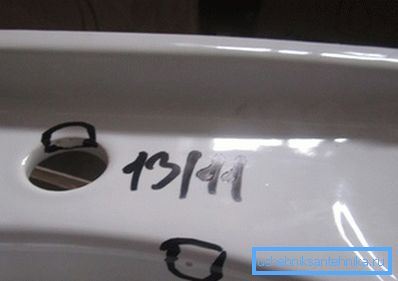
- Finally, you need to be careful when washing: despite the high density of the glaze, you should not expose the shell to metal sponges and abrasive powders: sooner or later scratches will appear that will become home to bacteria.
However, these disadvantages are very conditional, since with a responsible approach unpleasant consequences can be avoided.

Washbasin installation technology
Instructions for installing a faience or porcelain sink largely depends on its type.
Here we present an algorithm for mounting the most common, wall model:
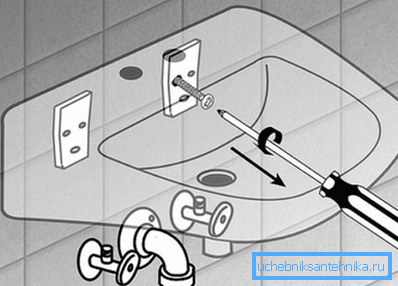
- To begin, choose the installation location of the sink. It is desirable that it be placed closer to the water supply pipes - then we will not have to lay a long hose from the place of the outlet.
- The height of the installation is chosen so that from the floor to the top edge of the sink was about 800 mm.
- Then we put the sink to the wall at the chosen height (here we will need the help of an assistant) and note the attachment points.
- At the marked points, drill holes with a diameter of 8 mm and more. For drilling use a perforator or hammer drill.
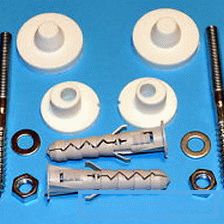
- We hammer in the dowels in the holes, then we tighten the hooks for hanging the sink. In some cases, long support brackets can be used instead of hooks - then fix them on the wall with anchors.
- We put the washbasin on the protruding screws. From the inside we fix it with retaining nuts with polymer pads. Screw nuts tightly, but without undue effort, so as not to damage the ceramics.
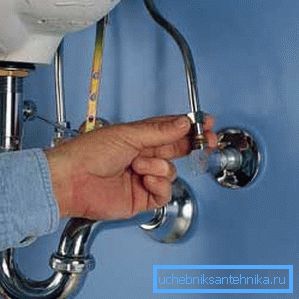
Note! When tightening the nuts, make sure that the bowl does not move and was placed strictly horizontally.
After that, our washbasin is ready to connect the drain siphon and mixer.
Conclusion
Ceramic semi-circular washbasins according to GOST, as well as other products made of porcelain, porcelain and earthenware, can be used almost everywhere. The variety of such products is quite large, so if necessary, we can always find and install a suitable model. More information about such constructions can be found on the video in this article.